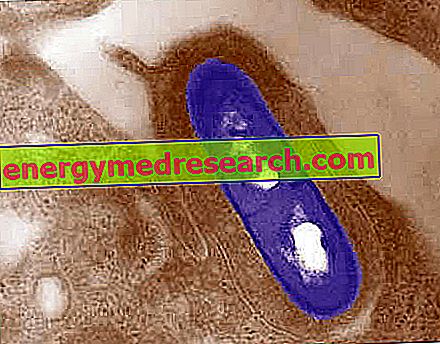Generality
Berdon syndrome is a rare congenital disease involving the bladder and the enteric tract.

This syndrome owes its name to Walter Berdon, the doctor who described it completely for the first time in 1976, identifying it in five girls.
In detail, it is a disease characterized by an excessive dilation of the urinary bladder and an important abdominal distension which is associated with a series of serious symptoms that can put the patient's survival at risk.
Unfortunately, the prognosis of Berdon syndrome is generally unfavorable and the disease can lead to tragic implications over a more or less wide interval of time, depending on the case.
The supportive treatment of this rare disease involves artificial feeding by parenteral route and urinary catheterization. Multiple organ transplantation appears to be a potential therapeutic strategy to significantly increase patient survival, however, this is a very complicated intervention accompanied by all the risks involved.
What is that
What is Berdon Syndrome?
Also known as the intestinal megacyst-microcolon-hypoperistalsis syndrome (or MMIHS, from the English Megacystis-Microcolon-Intestinal Hypoperistalsis Syndrome ), Berdon syndrome is a rare genetic disease . It is characterized by an excessive dilation of the urinary bladder and by an equally excessive abdominal distension which leads to a series of symptoms and disorders that make it impossible for the patient to have normal urination and nutrition, which must therefore be performed artificially.
The incidence of Berdon syndrome is not known (until 2012 only 230 certain cases have been described), however, it mainly affects female individuals . Transmission is autosomal recessive .
Causes
What are the Causes of Berdon Syndrome?
The cause of Berdon syndrome is to be found in genetic mutations . However, according to various sources, the exact gene responsible for the disease has not yet been precisely identified. Nevertheless, based on the hypotheses and studies carried out so far, it seems that the possible genes subject to mutations and involved in the origin of the syndrome are:
- The ACTG2 gene, coding for the γ-2-actin protein (present in the smooth muscle of the enteric tract);
- The LMOD1 gene, coding for the leiomodine 1 protein;
- The MYH11 gene, coding for the myosin heavy chain 11 ;
- The MYLK gene, coding for the myosin light chain protein (enzyme) kinase .
As can be seen, the genes that are thought to be involved in Berdon syndrome encode for muscle proteins or in any case for proteins implicated in the mechanisms that lead to the contraction of smooth muscles (including the bladder and enteric tract musculature).
Mode of Transmission of Berdon Syndrome
Although the gene precisely responsible for Berdon syndrome has not yet been precisely identified, the disease is thought to be autosomal recessive . This means that, to develop the syndrome and its symptoms, the newborn must have both mutated alleles of the responsible gene (s). These mutated alleles must therefore be transmitted by both parents, who will therefore be healthy carriers of the disease.
Manifestations and Symptoms
Manifestations and Symptoms Induced by Berdon Syndrome
As one can easily guess from the name with which it is often identified (megacisti-microcolon-intestinal hypoperistalsis syndrome), Berdon syndrome is characterized by:
- Enlarged bladder (megacisti) which, however, is not obstructed ;
- Restriction of the large intestine (microcolon);
- Generalized reduction of peristalsis of the intestine (intestinal hypoperistalsis) which, in the most serious cases, can also be completely absent (intestinal aperitifism).
Patients with the syndrome may also experience other abnormalities of the digestive tract, such as short bowel and intestinal malrotation . Along with the abnormalities of the enteric tract there are also other malformations of the urinary tract like dysplastic kidneys and urethral dilation .
The abdominal distension typically suffered by newborns suffering from the syndrome represents one of the early signs of the same.
Alongside the aforementioned manifestations symptoms such as biliary vomiting, difficulty in evacuating the meconium (a symptom which, among other things, contributes to the onset of abdominal distension as mentioned above), hydronephrosis and hydroureter also develop .
Due to reduced or completely absent peristalsis, infants with Berdon syndrome cannot eat normally, just as they encounter difficulties in normal urination.
Diagnosis
How is Berdon syndrome diagnosed?
Unfortunately, in the vast majority of cases, Berdon syndrome is diagnosed only after birth based on the clinical picture presented by the newborn and on the basis of any radiological and surgical investigations. In addition to this, it is also possible to resort to histological investigations which, generally, reveal a vacuolar degeneration of the central part of the smooth muscles of both the bladder and the intestine.
Given the mode of transmission of the disease, prenatal diagnosis is unlikely to be made, unless there are reasonable doubts that the newborn can be affected. In this case, through fetal ultrasound it is possible to highlight the enlargement of the urinary bladder and hydronephrosis (signs that, however, are only visible starting from the second trimester of pregnancy). Some studies, instead, for the execution of the prenatal diagnosis of Berdon syndrome, suggest the use of magnetic resonance in association with the analyzes of enzymatic modifications.
Differential diagnosis
The differential diagnosis must be placed against chronic idiopathic intestinal pseudo-obstruction (a rare disease that affects gastrointestinal motility) and against prune belly syndrome (from the English prune belly syndrome, it is another congenital disease characterized by an atrophy of the abdominal muscles which gives the belly of newborns who are affected a wrinkled appearance which reminds, precisely, of the surface of a prune).
Care and Treatment
Is there a cure for Berdon syndrome?
Over the years, several surgical treatments have been considered to combat Berdon syndrome in order to favor the patient's diet and urination, such as gastrostomy, jejunostomy and vesicostomy. Unfortunately, in most cases, these treatments have proved ineffective.
To ensure long-term patient survival, in fact, it is often necessary to resort to total parenteral nutrition - generally performed through central venous catheter (CVC) - and urinary catheterization (otherwise known as urinary or bladder catheterization).
Another possible surgical treatment proposed in various cases of Berdon syndrome is represented by the multi-organ transplant (or multivisceral transplant), ie by the transplantation of a good part of the organs involved by the syndrome (such as intestine, stomach, liver, biliary tract, spleen, etc.). ). Clearly, this is an operation as complicated as it is delicate that presents all the risks of the case and that cannot be performed on all patients.
Prognosis
What is the Prognosis of Patients with Berdon Syndrome?
Over the years, the survival of patients with Berdon syndrome has significantly improved thanks to innovation in the field of intravenous nutrition and thanks to the possibility of performing multivisceral transplants. Despite this, the prognosis of the rare disease in question remains rather unfavorable . In most cases, death is caused by multi-organ failure, the state of malnutrition and sepsis which can occur as a complication in patients with Berdon syndrome.



